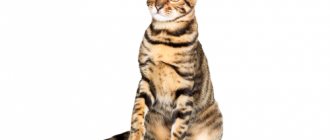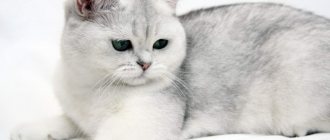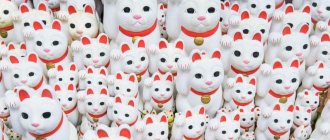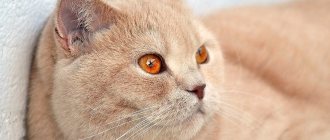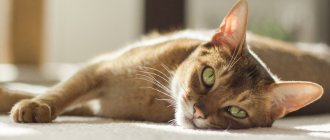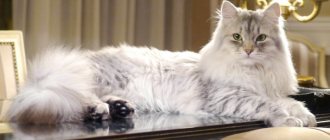History of the Toyger breed
The toyger is an artificially bred breed of domestic cat. Toyger is translated from English as a toy tiger cub (toy - toy, tiger - tiger). The cat's homeland is the USA. The idea to create a pet tiger came from Judy Sadgen. Judy has a construction background but is an architect by profession. However, this did not stop the woman from creating a separate breed.
Toyger - designer cat breed
It all started with the fact that Judy's mother (Jane Mill) was a breeder and in the 80s she tried to enhance the tabby color and give it color. But the crossings did not give the desired effect. Bengal cats took part in the selection, and the breeder was left with animals with a striped color. Moreover, the stripes were mainly on the body. Later, Judy drew attention to the cats. The kitten had similarities with a tiger cub, but there was still a lot of work to be done. Then the woman, like a real architect, drew an ideal tiger kitten on the computer.
Photographs of Savannah, Chausie, Bengal and an existing cat were used to develop the layout. The breeder managed to breed a cat with the color that was planned. The appearance of the toyger is unique, but there are still problems with breeding. But if the “correct” kittens are born, then from the first days you can eat little tiger cubs in them. In the early 90s, tiger cats were recognized as a breed. In May 2006, the Toyger was introduced as a TICA breed. A year later, the Toygers got the chance to participate in the TICA competition. And in the winter of 2009, the Toyger was recognized as a separate breed by the WCF Federation.
Savannah
A relatively new breed that was recognized by the Cat Fanciers' Association in 2012, the Savannah is known for its unusual appearance. Large, tall ears are located on the top of the head. The savanna is also characterized by a long neck, long legs and a short, thick tail. In addition, these cats have exotic spotted and striped coats. And this is not surprising, the wild appearance of the savannah was achieved by crossing the African serval with a domestic cat.
Description of the Toyger breed
A tabby cat should look like a tiger. The main distinguishing feature of the breed is its stripes. They can be ringed or broken. But there should be stripes even on the stomach and paws. In addition to color, this cat must have a lot of muscle. In general, the cat should look like a tiger in appearance. Otherwise, why bother getting a toyger at all? There are TICA and WCF standards; breeders or simply lovers of tiger cats must follow these specific descriptions.
Toygers have a unique appearance
And I saw a toyger alive at an exhibition (October 3-4). I first recognized the owner from the photo, and then I went to look for the toyger. Well, I’ll tell you the beast, and what impressed me was not the size, or even the color, but the fact that it was a solid lump of muscles, i.e. it was a BEAST.
Aganava, forum user
https://forum.cats-paradise.ru/viewtopic.php?t=174&start=170
Appearance of a cat
Cats and tabby cats are considered quite large (females - up to 5 kg, males - up to 7.5–8 kg). According to the standard, the toyger has a long, wide head. The muzzle is shaped like an inverted heart (from the forehead to the whisker pads). Side view of the head - half a hexagon (points: chin, nose, forehead, back of the head). The ears of a tiger pet are rounded and small. There is thick fur on the temples and ears.
A beautiful feature of Toygers is their eyes of a rich, bright color. They cannot be big, but they are always round. The upper eyelid is slightly drooping. The cat's nose is long, but rounded and slightly flared towards the tip. By the way, the cat’s nose is also not lacking in muscles.
Toygers have large, expressive eyes
The body of the striped animal is long, muscular, and athletic. The chest is wide, but the shape is round. The paws are strong, especially the front ones, and the toes are long. The toyger's tail is long and muscular. The tip of the tail is rounded (lowered). The tabby cat's fur is short. Typically, the stripes can be fluffier, which makes the design look more embossed. And also longer hair on the temples and cheeks (it gives off shine). The stripes can be black or brown (or both). A prerequisite is strong color contrast. The striped fibers are colored from root to tip. The stripes do not have to be even; they can be full or slightly rounded.
The toyger cub's undercoat is mousy (light, gray, ashy) in color. The paw pads and the very tip of the tail must be black. There are circular stripes on the face. The cat looks like he's wearing light glasses. This impression is created due to the lightened fur around the eyes.
Photo gallery: Toyger's appearance from different angles
The toyger has a long, straight nose with a dark border just above the tip
The toyger's paws should also be striped
The toyger's chest should be striped or spotted
The toyger has small, neat ears, with a rounded edge
The toyger's tail is always striped, the tip of the tail is black
Character of a tabby cat
People who have not delved into the history of the origin of the breed may decide that since the cat’s appearance is tiger, then its character is animalistic and aggressive. This is not the case with the Toyger. This is a friendly, tame treasure. Such animals cannot be jealous of the owner of other animals, so they get along with other pets (except rodents, of course). Neighborhood with another cat or dog is even useful, because this way the cat will not be bored. A cat will feel bad alone; he knows how to miss his human.
The tiger pet gets along well with children. He will never offend a child, and will even play with him. If someone else is being petted in front of the toyger, he will not envy and beg to be petted. Such cats do not show aggression towards anyone (with the exception of moments of obvious danger). In general, tiger cats are very good-natured and peaceful. But this does not mean that they can be offended with impunity. Tiger seals have excellent muscles, and if attacked, they can fight back. We must not forget that cats are natural predators.
Toyger cats love to quietly watch family members
Despite their outward indifference, these cats are not at all opposed to affection from their owner. Therefore, in order for an animal to be happy, it needs to be given attention. The pet will not remain in debt - toygers are very loyal. These animals are also very active and love to play. And if a loved one pets his pet, the cat can sit like that for hours. Another character trait of the toyger is developed intelligence. These cats are extremely inquisitive, they need to know everything. They can remember the habits and behavior of the owner, and if necessary, use this to their advantage (they can even cheat and deceive a person). If your pet is distracted from lying comfortably in a chair, he will try to take part in the home event that caused him to be woken up. An unusual addiction of toygers is that they love to lick the hands of their person (as well as the hands of other family members). Therefore, if there are children in the house, then they need to explain the need for frequent hand washing.
My cat also likes to lick my hands. And not only hands, but also nose and ears. She especially likes to do this in the morning. Nobody knows why this happens, but it definitely has nothing to do with toygers. Perhaps this is a way of showing love and care. After all, cats lick their kittens not only when they are dirty. I take this as a sign of high intelligence.
Appearance
The Toyger is a massive cat, reaching up to twelve kilograms in weight. Large, with large bones and heavy paws, it is a real predator. The standard prescribes the following characteristics for the breed.
Head.
Elongated, heart-shaped muzzle. Rounded ears. Small, deep-set eyes with half-lowered eyelids are distinguished by rich colors. Elongated nose, widening towards the end.
Frame
Low and long body, wide neck and chest. Powerful athletic paws. A wide, downturned tail with a rounded end.
Wool
Short, plush fur with a rich golden sheen. The pattern is “relief”: dark hairs are longer than light ones. The undercoat is soft and uniform. There is no ticking.
The main feature of the toyger is a modified tabby mackerel, a rare striped color. The main background is always contrastingly different from the color of the stripes.
The pattern consists of clear and bright vertical stripes covering the entire body and paws. The tip of the tail and paws are black. Stripes also cover the face. There are white “glasses” around the eyes.
Purchasing a toyger kitten
Some other breeds of kittens can be found outdoors. There are times when the owner fails to cope with responsibility and leaves his pet on the street. The cat breeds, but the kittens are born homeless. So with a striped breed this is impossible. Toyger is a new breed (and not the cheapest), which means such kittens could not end up on the street. This means that the kitten can be found from professional breeders or nurseries. There is a chance that your acquaintances will give you a tiger baby, but sometimes it is better to make a little effort than to wait for a miracle. To choose a cat, you need to remember the selection criteria.
In order for your pet to grow into a beautiful, healthy toyger, you need to choose the “right” kitten
Criterias of choice
Those wishing to purchase a real toyger must make their choice, adhering to the following criteria:
- The breeder's reputation must be good.
- Animals kept in the nursery must look healthy and well-groomed.
- The chosen toyger should behave calmly and friendly.
- The breeder must have all the necessary documents.
Find reviews of the breeder/kennel. The activities of the breeder must be transparent and their reputation must be good. When visiting the kennel, make sure the animals are kept clean. All pets should appear healthy and happy. Pay attention to the animals' behavior. If you see a frightened animal with aggressive behavior, this may indicate that pets are being abused. Such animals may experience stress, which means there may be problems with their health or behavior in the future.
the toy cub you like should look like a tiger cub
Ask for documents for the kitten. He must have a veterinary passport with vaccinations. In addition, you can ask for a pedigree. After all, a purebred baby can only be born to purebred parents. If a tabby kitten was born, for example, by a toyger cat, and its father is a purebred tabby cat, then you may not be provided with a pedigree. This is especially important if you plan to participate in championships and cat shows in the future.
At what age is it better to adopt a toyger?
Kittens should not be adopted immediately after birth. Breeders and veterinarians recommend adopting a baby from the age of three months. There are several reasons for this:
- primary immunity;
- vaccinations;
- raising a cat.
With mother's milk, the kitten receives primary immunity. This is the only way the baby will grow up strong and healthy. In addition, the mother cat will teach her cub to eat properly, go to the litter box and play. Kittens separated from their nurse early may grow up unadapted to life. And most importantly - vaccinations. Usually, up to three months, kittens receive the most important vaccinations. Even if you persuade the breeder to give the kitten away a little earlier, he may require you to sign an agreement in which such an obligation will be indicated. But in general, professionals do not give away purebred kittens early. The new owner may be irresponsible, and in the world of breeders, the loss of every kitten is a terrible loss. There can be only one exception to this rule - the death of a cat. If a toyger cub is left without a mother, a person will have to feed it (first from a pipette, then from a bottle). Not all breeders can cope with the great responsibility, so such a baby may be given away.
It is not recommended to adopt a kitten under three months old
I had to feed a kitten with a pipette. It's difficult and scary. Small kittens (especially while they are blind) may snort, gag, and turn away. But the baby must gain weight, so it is important that he still eats.
Asian tabby
The brindle pattern is found among both short-haired and long-haired felines.
The Asian tabby cat is an animal with an exotic tiger color. The color of the coat can reach gray and silver shades, not at all reminiscent of its predatory counterpart. The formation of kittens' coloration can take from several weeks to two to three months. Purchasing an expensive friend is only possible at a specialized breeding farm upon pre-order.
The cost of a pet depends on the pedigree history, color contrast and characteristic pattern. Belonging to a certain class determines the final price. Pet class with differences from the standard color is estimated at 15-30 thousand rubles, Brit class with minimal errors in the standard - from 30-40 without the right and up to 60-70 thousand with the right to further breeding. Show class is a brindle cat with an ideal pattern and the right to breed. It costs from 80 thousand.
Toyger content
You can’t take a toyger and just throw it into an apartment so that it “settles in” on its own. The tiger pet must be provided with the conditions necessary for proper growth and development. Generous owners buy/build play complexes for their pets (house, bed, ladder, shelves). The toyger must have a place where he can sleep, play, and, if necessary, hide. A cat of this breed is extremely inquisitive, which means it should be able to observe what is happening in the house. You can provide a place for viewing (for example, a couch at some height from the floor). In addition, when purchasing a toyger, you must know what to feed it and how to care for it.
Before you bring home a toyger, you need to equip a playground for him
What to feed your tabby pet
Toygers are unpretentious cats, but this does not mean that they can be fed with anything. Owners of tabby cats are divided into two types: those people who feed their pet natural food, and those who buy ready-made food. It is impossible to make a categorically correct choice. You can feed a cat only dry food, but it will lose interest in natural food. You can feed your pet only natural products (it’s also cheaper), but in this case the cat may not receive enough vitamins.
I try to feed my cat natural food (she loves this food very much). But in the morning, when I leave for work, I pour dry food into her bowl so that the cat has breakfast without me. Sometimes I buy her wet food just to “pamper” her, but it’s more expensive than dry food, so we rarely have such belly celebrations. Natural food is much cheaper, and it’s also healthier, because I make the menu myself. However, just a cutlet from the table will not work; you have to prepare it specially.
A tiger cat can eat almost anything from natural food. Basically, the diet for cats consists of the following products:
- meat (beef, chicken, offal);
- egg;
- vegetables (almost any);
- cereals (rice, buckwheat);
- dairy products.
For a cat to be healthy, it needs to be fed properly
It is important to remember the list of products that are not recommended for toygers:
- fish (it has a lot of bones, and toygers don’t like it);
- milk (cats may have indigestion);
- salt (harmful to the kidneys);
- seasonings;
- fatty foods;
- smoked meats.
Nothing bad will happen if your tiger begs for a small piece of sausage or cutlet. But it’s better to try to avoid this too. In general, the choice of food should depend on the cat’s preferences. After all, if you offer a cat only buckwheat porridge without salt and butter, then she will eat it because she is hungry, and not because she adores buckwheat. Some animals love raw vegetables or fruits. This is useful because they contain a lot of fiber, which helps pets cleanse their gastrointestinal tract of excess hair. And some people love sweets. It is better to avoid such products, but the toyger is a cunning animal; it can deceive its owner and steal a piece of chocolate.
My cat rolls her eyes when she sees a can of canned corn. No other “goodies” can distract her when someone takes these corn out of the jar. It's unhealthy and (probably) not very tasty, but my cat can be made to stand on her hind legs by holding a pop of corn in her hand.
When choosing food, it is important to take into account the cat’s wishes
Toygers, like most other cats, are fed twice a day (kittens can be fed more often). The amount of daily serving depends on the age of the animal and its condition. In general, tiger cats themselves are not thin, so it is difficult to keep track of the animal’s figure. But the owner must remember that with excess nutrition, cats become fat. All systems of the cat's body suffer from this. In addition, a hungry cat will not sit still quietly; she will definitely make it clear that it is time to feed. You can accustom your toyger to a routine. If you give food at the same time, the animal will definitely remember it.
Caring for your cat's appearance
There are no special recommendations for caring for the appearance of a toyger. These are cats that mostly cope with this task on their own. They lick themselves frequently and thoroughly. However, it is advisable for the owner to do the following:
- periodically brush your pet’s teeth;
- examine the animal’s ears;
- occasionally brush the cat's fur.
brindle cats are real clean people
To brush their pet's teeth, many wrap gauze around their finger. You can also use a dampened cotton swab. You can also buy a special toothbrush. Toygers are not particularly prone to dental diseases, but you can contact a veterinarian at least once a year to have him examine the animal’s oral cavity. You can also clean your cat's ears with a cotton swab. This must be done carefully so as not to cause pain to the animal.
Brushing and bathing
You can comb a tiger cat, but it is not necessary. You can use a brush to comb out. It is advisable that the tool have natural bristles. In general, toygers do not shed much, but during the molting period a few hairs will stand out from the total mass. In such cases, you can simply run your wet hand over the fur. The fur of these cats is soft and shiny, more like faux fur. Taking care of her is a real pleasure.
My cat sheds very little. We have a comb and a brush, but I remove fallen hairs with a wet hand. It's easier, faster and more enjoyable for the cat.
It is also not necessary to bathe your toyger. You can wash it if the wool gets dirty. It is advisable not to bathe your cat more often than once every 2 months. When swimming, you need to be careful; toygers are calm in the water, so they may not calculate their strength and “drink” water.
Video: tiger kitten bathes in the bath
Character
Toygers are moderately active cats. Calm by nature, they are friendly but not intrusive. Smart and intelligent, no whims or unreasonable screams or begging for food. Curious and smart. They quickly learn commands such as “no”, “bring”.
Sociable with hosts and guests, not cowardly. Jealousy is not inherent in them - they calmly treat other animals in the house and are friends with them.
Toyger owners talk about the extraordinary affection of this breed. This is true. Toy does not like to be alone for a long time; he definitely needs someone nearby. The cat does not require attention, is self-sufficient, but will never be against stroking.
They do not like enclosed spaces: they may become “indignant” when transported in a carrier, and become agitated in a car.
Vices of tiger cats
When a person adopts a purebred kitten, he wants the animal to live as long as possible. If the pet is a family member, then its life expectancy is especially important for impressionable people (for example, children). And in the case when the animal was purchased for breeding, then the owner may suffer financial losses due to the cat’s illness. Therefore, it is especially important to know about all the pet’s inclinations in advance.
Typically, breed defects include a cat’s predisposition to various diseases and abnormalities. To find out about the individual characteristics of your pet, check them with the breeder or the owner of the nursery (where you got the kitten).
Toygers are characterized by good health
Tendency to diseases
Since the breed is quite young, it is not yet completely clear whether they can have genetic diseases. But in any case, you need to monitor your cat’s health and make preventive visits to the veterinarian. Typically, the following signs indicate a cat’s illness:
- refusal to eat or poor appetite;
- weight loss or sudden weight gain;
- lethargy or aggression, nervousness;
- redness, peeling of the skin;
- the appearance of bald patches;
- discharge from the eyes, nose;
- increased or decreased temperature;
- blood in the discharge, difficulty urinating or stopping it altogether;
- diarrhea, vomiting;
- swelling, redness of the eyelids;
- cataract; protrusion of the eyeball;
- an increase in the size of the liver, felt upon palpation.
If you notice any of these symptoms, you should contact your veterinarian.
I always recommend that all cat owners keep close contact with a local or private veterinarian. For example, you can call our veterinarian directly on his cell phone at any time. If there is an urgent need, he can come.
Toygers have no predisposition to diseases
No external defects were found in the toyger either. However, any deviation from TICA standards may prevent your pet from earning a championship title. There are general criteria by which a purebred cat may be disqualified or not allowed to participate. These criteria include the following:
- absence of testicles: unilateral (monarchism) or bilateral (cryptorchidism);
- underdevelopment of one or two testicles in uncastrated cats older than 10 months;
- absence of claws (successful);
- multiple fingers (polydactyly) or absence of fingers (olidactyly);
- dwarfism;
- blindness or permanent squint (strobism);
- turning of the eyelids inwards (entropion);
- the presence of an umbilical hernia;
- there are white spots that are not provided for by the standard.
However, if the cat is primarily a member of the family, then being excluded from the show (or disqualified) will not make you love your pet any less than before.
Pixie bob
To develop a breed of cat that resembles a lynx, breeders used short-tailed forest cats. These animals live in the forests of North America. The first cat obtained in this way was named Pixie, which means “Elf” or “Fairy” in English.
The animals are distinguished by a short tail, tufts on the ears and whiskers are possible. Pixies are unpretentious, train well and easily make contact with people.
Is it possible to breed Toyger cats?
many owners of purebred cats want to get the same purebred offspring
An inexperienced cat breeder will not be able to breed toygers on his own. The breed is still in its infancy, the characteristics of its representatives are unstable. Therefore, if you want to crossbreed your tiger cat with a male cat, it is better to contact a professional breeder. If the owner breeds his toyger cat with a cat of another breed (or outbred), then the kittens born will lose the purity of the breed. Babies may not display the necessary signs of the standard. Even more experienced breeders, crossing toygers with each other, sometimes get kittens with insufficiently rounded ears, a sharp muzzle or stripes on the stomach. Of course, no one can stop you from taking a chance, but trying to breed may look like you are trying to get striped kittens for sale. Especially if your cat has a pedigree and/or has participated in shows.
If you still have to tie up a cat, then remember the main rule: the cat must be old enough (at least 1.5 years old). The cat must be absolutely healthy, vaccinated and adequate. The female toyger is a shy cat. And there is no need for the cat to offend/hurt her, etc.
In cases where the brindle cat will live the life of a regular house cat, you need to keep in mind the frequency of births. Everyone knows the fact that cats often give birth. However, veterinarians and professional breeders do not recommend breeding a cat more than once a year. The fact is that with frequent pregnancy and childbirth, the cat’s body will not have time to recover. A cat that has just given birth may lose weight, its fur may become dull, and it may generally feel weak and unwell.
Castration and sterilization of toygers
Breeders try to castrate/sterilize the animal while still in the nursery (before the moment when the new owner takes the kitten). This operation involves removing the gonads. The procedure itself lasts about 15 minutes. Usually castration is carried out under local or general anesthesia, and sterilization is strictly under general anesthesia. If you get an unsterilized toyger, wait until puberty (9–10 months) and contact a veterinary clinic. You will be asked to undergo tests and deworm your pet. All that remains is for the cat to come out after the operation.
If the cat was not purchased for breeding, then it must be sterilized
The most difficult thing after surgery is your personal feelings. When my cat was sterilized, I felt incredibly sorry for her. She mumbled something inaudibly, she was constantly drooling and could not get up. Although the vet said she doesn't feel pain. On the second day she recovered from anesthesia, but attempts began to remove the blanket. The knots from the blanket were tied at the back, but she somehow managed to pull it down to her shoulder blades. She made no attempt to lick the stitches, but I have heard of other cats picking at the stitches.
Video: how to care for a cat after surgery
Breeding
Toygers are bred by professionals. Individuals have the right to position their own kittens as “pets.”
Large catteries operating under the Judy Sugden system sell cats with breeding rights only to reputable breeders. The remaining animals are spayed or neutered.
Before sale, a breeding inspection is carried out, where their thoroughbred is confirmed.
Mating and partner selection
Breeders carefully select partners, trying to emphasize certain traits. The breed is difficult to work with. It takes decades to fix the parameters.
Crossing Toyregs with other breeds is prohibited. The resulting kittens are subject to culling and sterilization.
Pregnancy and childbirth
Toygers tolerate pregnancy and childbirth well. Gestation lasts about 65 days. In a litter, the female brings 4-5 kittens.
Breeders carefully select partners, trying to emphasize certain traits
Table: pros and cons of the Toyger breed
| Criterion | pros | Minuses |
| Appearance | pretty appearance, bright color, small size | due to the well-developed muscular system, you may not notice fullness |
| Character | Toygers - smart, kind, affectionate, balanced, not jealous | a cat can remember where the food is and deceive its owner |
| Content | Toygers are unpretentious and can adapt to any proposed conditions | — |
| Nutrition | food can be anything (dry or natural) | many prohibited foods |
| Appearance care | lick themselves, clean | — |
| Health | no predisposition to diseases has yet been found | — |
| Breeding | the cat can be crossed with any healthy cat | Toygers are bred only in nurseries (by professional breeders) |
| Reviews | everyone who has seen a Toyger at exhibitions speaks positively about the breed | — |
| Price | a toyger kitten can cost from 10 thousand rubles | the price of a toyger with a pedigree can reach 200 thousand rubles (and higher) |
Balanced diet
The main requirements when preparing a diet for a cat are balance and saturation with microelements. It is better to feed your pets with premium and super-premium food.
Dry food and solid food are required for self-cleaning in the process of feeding plaque.
Color
The color is characterized by stripes ranging from black to brown. An integral part is the highlighted background color. It should be as close as possible to tiger, especially the color of the back.
The mini tiger may have stripes, spots and rosettes. On the muzzle there is a pattern in the form of a butterfly. The cat's round fur is covered with vertical stripes. They are called tabbies. Let's say dark brown.
The peculiarity of toyger wool is its shine and elasticity. The color of the toyger is characterized by relief. This is achieved due to the increased length of the pile in place of the pattern. The breed is classified as shorthaired.
A feature of mini-tigers is the presence of a collar - a thicker coat of hair at the temples and on the cheekbones.
Interesting photo
Calm grace
Yes, it's a tiger, just a small one
After games you need to rest
Before the jump
Handsome Toyger on a green background
How to choose a kitten
Important! Only official nurseries have the right to sell toygers. The responsibility for maintaining the purity of the Toyger cat breed is too great. Only dubious establishments that carry out illegal breed mixing can offer to buy such a kitten cheaply.
Before you pick up kittens, you need to familiarize yourself with their pedigree, in which absolutely all representatives must be of the same breed - toyger.
Next, you can begin to examine the baby’s exterior, which can be fully assessed when they are three months old.
It’s good if you have previously studied the color features of the breed and can distinguish it from an ordinary mustachioed-striped yard cat.
The health of the kitten is an important aspect. Once you are sure that this is a real domestic tiger, take a close look at the following:
- evaluate the cleanliness of the ears, nose and eyes;
- the tummy should be soft;
- rashes, redness or peeling of the skin indicate an illness in the baby.
You can separate a kitten from its mother at 2 - 2.5 months
Application
Toygers become equal members of the family and everyone's favorites. Exotic appearance and affectionate character can melt even the coldest hearts.
In addition, European and American breeders finance charitable foundations. The activities of these organizations are aimed at preserving the tiger population in their natural habitat.
Additional care
Artificially created varieties of the tiger breed are highly prized. Genetic studies prove a direct connection between the genes responsible for body color and the animal’s immunity. Selected cat breeds, despite the fact that their wild counterparts have excellent immunity, require additional attention to the nutrition and care of the pet.
The need for annual vaccinations and additional vitamins is mandatory for valuable representatives of the feline class. Monitoring the health of the eyes, heart and blood vessels will allow timely prevention of possible disease.
Representatives of many tiger breeds are long-lived; their lifespan is about 20 years with proper nutrition and lifestyle. The need for walks in the fresh air obliges the owner to think through ways and times for such activities.
Health
Typically, wild-type animals are very resilient and disease-resistant, unlike their bred counterparts. Modern genetic studies have shown that the T gene, which determines the brindle color, is directly related to immunity.
We invite you to read: The main difference between food for sterilized cats and regular food: how to choose
Artificially created breeds, more than the descendants of their “wild” counterparts, are susceptible to diseases such as:
- cardiomyopathy;
- cardiac hypotrophy;
- cataract;
- feline leukemia.
The rest of the “tiger cubs” mostly suffer only from the same diseases that ordinary domestic cats suffer from:
- colds;
- infections;
- poisoning
Nutrition
The diet of a domestic predator should be varied, it includes meat and lactic acid products, vegetables, and vitamin supplements. Unable to tolerate a monotonous diet due to their being natural hunters, tiger individuals consume only fresh, nutritious food. Long-haired cats that undergo seasonal shedding require additional care. Frequent bathing is not particularly recommended; animals clean their own fur.
Striped felines have become so close to humans that life without them becomes boring and uninteresting. But it’s not always worth “chasing” a breed. Any stray cat can turn into a gorgeous, handsome cat, feeling the care and affection of its owner.
